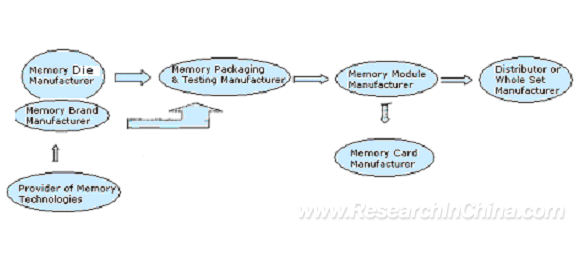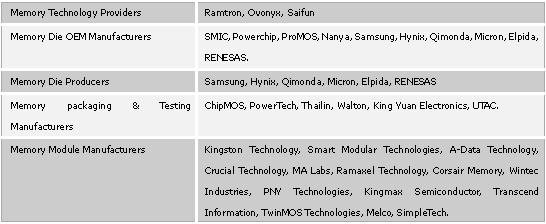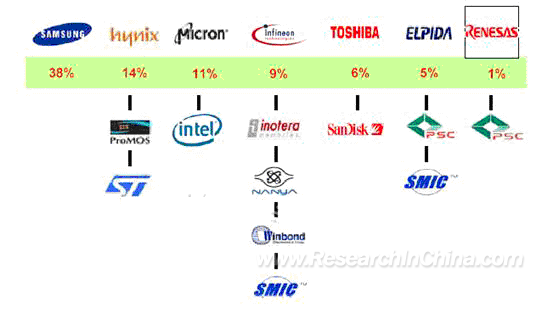| |
|
 |
Memory is an electronic component indispensable to nearly all electronic products. By application, memory can be divided into three major categories, which can be represented by NAND Flash, DRAM and, NOR Flash and EEPROM respectively.
Undoubtedly, memory is of the greatest potential in electronic industry now that the demand of any memory category has been increasing rapidly. Despite the ever decreasing price, the capacity of memory keeps growing, which can offset the lost profits caused by price decline. Due to the fast upgrading of memory industry, new products, particularly in the field of DRAM, can generate huge profits. It took only one year for DDR2 substituted for DDR. Likewise, DDR2 will be replaced by DDR3 in two years or so. The gross profit margin of memory industry is usually above 15%.
Sketch Map of Memory Industry Chain

Some memory producers, usually, take up with the production on their own. In the event of insufficient production capacity, they will seek for OEM wafer fabs. Other manufacturers exchange their technologies for production capacity, like Elpida and Renesas for the production capacity of Powerchip, HYNIX for that of ProMOS Technologies and, Qimonda for that of Nanya Technology.
Main Manufacturers in Memory Industry Chain

As to memory die, most producers need the partners both in capital and technologies.

Except for Samsung, other memory manufacturers has their allied partners, such as the alliance of Hynix, ProMos and STMicroelectronics, the alignment of Micron and Intel, the coalescent of Infineon, Inotera, Nanya, Winbond and SMIC, the ally of Toshiba and SanDisk, the union of ELPIDA, Powerchip and SMIC, and the joint hands of Renesas and Powerchip.
The packaging and testing field, with higher threshold than memory die, requires to be supported by sufficient capital, technical strength and steady customers. It is beyond doubt that only Taiwanese manufacturers can do this. In the field of memory packaging, almost all memories are packaged by Taiwanese producers except for Samsung. PowerTech, ChipMOS and Walton take some 90% of the market shares. As for memory testing, PowetTech, UTAC, King Yuan Electronics and Thailin seize the majority of market shares. As for the packaging and testing field, PowerTech invested by Kingston is regarded as the leader and its production capacity utilization rate is as high as 100% with a gross margin of 30% plus.
Memory module refers to the making of memory dies, PCB and passive components into a practical memory stick. Few memory die producers like Samsung can manage the memory modules by themselves. Such producers are generally called as third-party memory module manufacturers. However, the majority of them only owns SMT production lines and can not embark on memory packaging and testing. In comparison, only a small number can do the testing. Memory packaging has to be contracted to professional packaging enterprises.
The third-party memory module manufacturers mainly focus on the retailing DIY market, and target Samsung and Hynix as the OEM market. The success of third-party memory module manufacturers mainly attributes to the market promotion and brand image. Therefore, most producers attach great importance to the promotional activities instead of products in DIY market.
The gross margin of the third-party memory module manufacturers is as low as 7-10%. Kingston, backed by Samsung, has almost monopolized the market for years while other producers only share less than 10% of market respectively. For the third-party memory module manufacturers, Tainwan-based companies are the main bodies and then come to American channel partners.
|
|
|
|
|
If this report could not still meet your requirement, or
you have any comments or suggestions on it, please leave a
message to us.
|
2005-2008 www.researchinchina.com All Rights Reserved
| |
|
 |
| |
|
Memory is an electronic component indispensable to nearly all electronic products. By application, memory can be divided into three major categories, which can be represented by NAND Flash, DRAM and, NOR Flash and EEPROM respectively.
Undoubtedly, memory is of the greatest potential in electronic industry now that the demand of any memory category has been increasing rapidly. Despite the ever decreasing price, the capacity of memory keeps growing, which can offset the lost profits caused by price decline. Due to the fast upgrading of memory industry, new products, particularly in the field of DRAM, can generate huge profits. It took only one year for DDR2 substituted for DDR. Likewise, DDR2 will be replaced by DDR3 in two years or so. The gross profit margin of memory industry is usually above 15%.
Sketch Map of Memory Industry Chain

Some memory producers, usually, take up with the production on their own. In the event of insufficient production capacity, they will seek for OEM wafer fabs. Other manufacturers exchange their technologies for production capacity, like Elpida and Renesas for the production capacity of Powerchip, HYNIX for that of ProMOS Technologies and, Qimonda for that of Nanya Technology.
Main Manufacturers in Memory Industry Chain

As to memory die, most producers need the partners both in capital and technologies.

Except for Samsung, other memory manufacturers has their allied partners, such as the alliance of Hynix, ProMos and STMicroelectronics, the alignment of Micron and Intel, the coalescent of Infineon, Inotera, Nanya, Winbond and SMIC, the ally of Toshiba and SanDisk, the union of ELPIDA, Powerchip and SMIC, and the joint hands of Renesas and Powerchip.
The packaging and testing field, with higher threshold than memory die, requires to be supported by sufficient capital, technical strength and steady customers. It is beyond doubt that only Taiwanese manufacturers can do this. In the field of memory packaging, almost all memories are packaged by Taiwanese producers except for Samsung. PowerTech, ChipMOS and Walton take some 90% of the market shares. As for memory testing, PowetTech, UTAC, King Yuan Electronics and Thailin seize the majority of market shares. As for the packaging and testing field, PowerTech invested by Kingston is regarded as the leader and its production capacity utilization rate is as high as 100% with a gross margin of 30% plus.
Memory module refers to the making of memory dies, PCB and passive components into a practical memory stick. Few memory die producers like Samsung can manage the memory modules by themselves. Such producers are generally called as third-party memory module manufacturers. However, the majority of them only owns SMT production lines and can not embark on memory packaging and testing. In comparison, only a small number can do the testing. Memory packaging has to be contracted to professional packaging enterprises.
The third-party memory module manufacturers mainly focus on the retailing DIY market, and target Samsung and Hynix as the OEM market. The success of third-party memory module manufacturers mainly attributes to the market promotion and brand image. Therefore, most producers attach great importance to the promotional activities instead of products in DIY market.
The gross margin of the third-party memory module manufacturers is as low as 7-10%. Kingston, backed by Samsung, has almost monopolized the market for years while other producers only share less than 10% of market respectively. For the third-party memory module manufacturers, Tainwan-based companies are the main bodies and then come to American channel partners.
|
|
|
|
|
2005-2006 www.researchinchina.com All Rights Reserved |
|
| |
|
 |
| |
|
1. Brief Introduction to Memory
1.1 Classification of Memory
1.2 Brief Introduction to Next Generation Flash Memory
1.2.1 PRAM
1.2.2 MRAM
1.2.3 FRAM
1.2.4 Ramtron2. Memory Industry Chain
2.1 Brief Introduction to Memory Industry Chain
2.2 Status Quo and Future Trend of DRAM Die Production Industry
2.3 Status Quo and Trend of NAND Flash Die Production Industry
2.4 Status Quo and Trend of NOR Flash Industry
2.5 Status Quo and Trend of Mobile Phone Memory Industry
2.6 Status Quo of Memory Module Industry 3. Status Quo of Memory Market
3.1 Status Quo of DRAM Market
3.2 Status Quo and Trend of NAND Flash Market
3.2.1 Downstream Markets of NAND Flash
3.3 Mobile Phone Memory Market 4. Research on Memory Die Manufacturers
4.1 Samsung
4.2 ProMOS
4.3 Powerchip
4.4 STMicroelectronics
4.4 SanDisk
4.5 Nanya
4.6 Winbond
4.7 Qimonda
4.8 Hynix
4.9 Micron
4.10 Intel
4.11 Elpida
4.12 Toshiba
4.13 Spansion
4.14 Etron
4.15 Macronix
4.16 SST
5. Memory Packaging and Testing Enterprises
5.1 Status Quo of Memory Packaging and Testing Industry
5.2 PowerTech
5.3 THAILIN
5.4 Walton Advanced Engineering Inc.
5.5 ChipMOS
5.6 King Yuan Electronics
5.7 UTAC 6. Memory Module Manufacturers
6.1 Kingston
6.2 A-DATA
6.3 Smart Modular Technologies
6.4 Ramaxel Technology
6.5 TwinMOS
6.6 Transcend
|
|
|
|
|
2005-2008 www.researchinchina.com All Rights Reserved |
|
| |
|
 |
| |
|
Development Roadmap for the Rates of Memories, 2000-2011
Structure of MRAM
Basic Principle of MRAM
Applications of FRAM in Automobile Field
Product Revenue of Ramtron, 2003Q4-2006Q3
Proportion of Product Applications of Ramtron, 2005-2006
Sketch Map of Memory Industry Chain
Distribution of Alliances of Memory Industry
Market Shares of Major DRAM Manufacturers (by Income) Worldwide, 2006
Market Shares of Major DRAM Manufacturers (by Bits) Worldwide, 2006
Proportions of Major DRAM Manufacturers by 12-inch Wafer Production, 2006Q4
Market Shares of Major NAND Suppliers, 2006
Market Shares of Major NAND Suppliers, 2007
Market Shares of Major NOR Manufacturers, 2005
Market Shares of Major NOR Manufacturers, 2006
Development Roadmap for Mobile Phone Memory
Roadmap for Mobile Phone Memory Packaging
Average Sales Prices of DDR2 512Mb 667MHz DRAM, Oct 2005-Jan 2007
Average Sales Price of 256Mb Memory, 2001Q4-2007Q4
Proportions for Downstream Applications of DRAM (by Bits), 2010
Proportions for Downstream Applications of DRAM (by Income), 2010
Proportions for Downstream Applications of NAND Flash, 2000-2010
Statistics and Forecast of USB Disk Market Scale, 2005-2009
Statistics and Forecast of the Shipment of Flash MP3 Players, 2003-2009
Statistics and Forecast of Game Card Shipment, 2005-2009
Statistics and Forecast of Average Capacity of Game Cards, 2005-2009
Forecast of Flash Notebook Shipment, 2006-2010
Statistics and Forecast of Mobile Phone Shipment, 2005-2010
Proportion of Product Revenue of Samsung, 2005-2006
Proportion of Product Profit of Samsung, 2005-2006
Roadmap for Samsung's DRAM Technology
Roadmap for the Memories for Server, Notebook and Desktop PC, 2006-2009
Roadmap for Samsung's DRAM Module
Roadmap for Samsung's Mobile-DRAM/SRAM
Roadmap for Samsung's OneNAND
Roadmap for Samsung's Flash Memory
MCP/POP Solution for Samsung Mobile Phone Memory
Organizational Structure of ProMOS
Wafer Fabs of ProMOS
Monthly Income of ProMOS, 2006Q1-2007Q2
Organizational Structure of Putian ProMOS Technologies (Chongqing)
Organizational Structure of Powerchip
Wafer Fabs of Powerchip
Technical Roadmap of Powerchip
Quarterly Revenues of STMicroelectronics, 2004Q1-2006Q4
Proportion of Product Application of STMicroelectronics, 2006
Structure of Product Income of STMicroelectronics, 2005
Quarterly Income of SanDisk, 2003Q1-2006Q4
Statistical Gross Profit Margin of SanDisk, 2003-2006
Roadmap for NAND Technology of Sandisk
Roadmap for NAND Products of Sandisk
SanDisk Technology Transition for Total Captive Wafer Production by GB
Statistical Revenue and Operating Gross Profit of Winbond, 2005Q1-2006Q4
Revenue and Gross Profit Margin of Winbond by Division, 2005Q1-2006Q4
Revenues of Winbondby Product, 2006Q4
Statistical Sales Income of Qimonda, FY2003-2007Q1
Statistics on Gross Profit and Gross Profit Margin of Qimonda, 2003-2007Q1
Statistics on R&D Expenditure of Qimonda, 2003-2007Q1
Statistical Yields of Qimonda, 2003-2007Q1
Revenues of Qimonda by Region, 2006
Compositional Proportion of Product Income of Hynix, 2005Q3-2006Q4
DRAM Average Price and Shipment of Hynix, 2006Q1-2007Q4
NAND Average Price and Shipment of Hynix, 2006Q1-2007Q4
DRAM Average Price and Shipment of Hynix, 2005-2008
NAND Average Price and Shipment of Hynix, 2005-2008
Proportion of Product Revenue of Micron, 2004-2006
Statistical Income and Gross Profit Margin of Micron, 2006Q1-2007Q1
Statistics on R&D and Administrative Expenses of Micron, 2006Q1-2007Q1
Proportion of Wafer Applications of Micron, FY2007
Proportions for Manufacturing Techniques of Micron’s Wafer Fabs, 2006-2007
Features of Intel Flash Memory
Capital Stock Structure of StELPIDA
Sales Income and Operating Profit of ELPIDA, 2003Q1-2006Q3
Statistics on Product Application Proportion of ELPIDA, 2005Q3-2006Q3
Output Planning of ELPIDA
Expansion Plan of NAND Wafer Fabs of Toshiba, 2004-2008
Sketch Map of MirrorBit
Product Structure of SPANSION
Statistical Revenue and Operating Profit Margin of Etron, 2001-2006
Corporate Structure of Etron
Quarterly Income and Gross Profit Margin of Macronix, 2002Q2-2006Q4
Proportion of Product Income of Macronix, 2005Q4-2006Q4
Proportion of Product Revenue of Macronix, 2005-2006
Proportion of Product Shipment of Macronix, 2005-2006
Structure of Manufacturing Procedure Income of Macronix, 2005Q4-2006Q4
Revenues of Macronix by Region, 2005Q4-2006Q4
Product Shipment of SST, 1995-2005
Licensed Product Shipment of SST, 2000-2005
Wafer OEM Partners of SST
Back-end Packaging and Testing Partners of SST
Proportion of Product Applications of SST, 2006Q1
Revenues of SST by Region, 2006 Q1
Technical Roadmap of SST
Revenues of SST, 2003Q1-2006Q1
Proportion for Revenues of SST from Non-memory Products, 2003Q1-2006Q1
Patent Licensing Income of SST, 2003Q1-2006Q1
Revenues of SST by Region, 2005Q4, 2006Q3 and 2006Q4
Proportion of Operating Cost of SST, 2006Q3-Q4
Statistics and Forecast of Revenues, Gross Profit Margin and Operating Profit
Margin of Walton Advanced Engineering Inc., 2004-2007
Statistical Gross Profit Margin of ChipMOS Technologies Inc., 2004Q1-2006Q3
Revenue and Operating Profit Margin of King Yuan Electronics, 2004-2007
Organizational Structure of King Yuan Electronics
Statistical Revenue and Gross Profit Margin of UTAC, 2001-2006
Customers of UTAC and NSEB
Proportion of Revenue of UTAC, 2006Q1
Revenue of UTAC by Region, 2006Q1
Statistical Profit Margin of A-DATA Technology, 2004Q1-2005Q4
Revenue of A-DATA Technology by Region, 2005
Revenue of A-DATA Technology by Product, 2005
Statistical Sales Income of A-DATA Technology, 2003Q1-2006Q3
Statistical Net Income of A-DATA, 2003Q1-2006Q3
Structure of Product Income of A-DATA Technology, 2006Q1-Q3
Statistical Revenue and Gross Profit Margin of Smart Modular, FY2002-2007
Statistical Revenue of Transcend, 2001-2006
Performance Comparison of MRAM, SRAM, DRAM, FLASH and FRAM
Major Manufacturers in Memory Industry Chain
World's Top 20 Memory Module Producers by Income, 2005
Ranking of World's Top Ten Memory Module Manufacturers, 2006H1
Memory Wafer Fabs of Samsung
Total Capital Invested into Wafer Fabs of SanDisk, 2004-2009
Wafer Fabs of Spansion
Testing and Packing Plants of Spansion
Proportion of Business Income of PowerTech Technology
Investment Plans of ChipMOS Technologies, 2006
Proportion of Customers of King Yuan Electronics, 2006
Statistics on Machine Sets of UTAC and NSEB
Cooperative Partners of Ramaxel Technology
|
2005-2008 www.researchinchina.com All Rights Reserved
|



